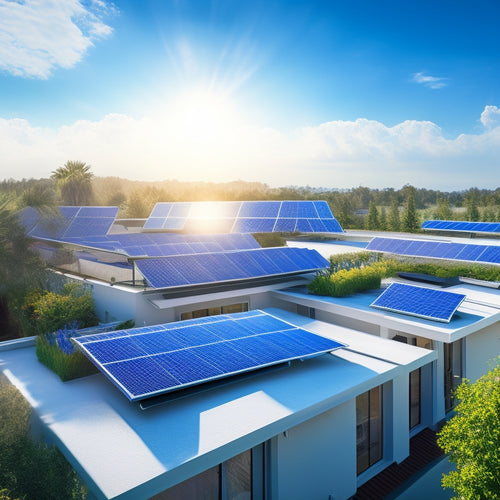
Boosting Solar Panel Performance and Efficiency
Share
You can enhance your solar panel's performance and efficiency by optimizing panel angle and tilt, ensuring maximum sunlight exposure throughout the year. Regular cleaning and maintenance are also vital, as dirt and debris can reduce energy output. Implementing tracking systems and peak power tracking can further improve energy harvest, while enhancing inverter efficiency ratings and heat management strategies can minimize energy losses. By monitoring performance with data analytics, you can identify trends and potential issues, guiding maintenance schedules and system optimization efforts. Now, you're just a step away from revealing your solar panel's full potential.
Key Takeaways
- Optimize panel orientation and tilt to capture maximum sunlight, adjusting seasonally for steeper angles in summer and shallower in winter.
- Regularly clean panels to prevent dust, dirt, and debris from reducing energy output, using gentle tools and avoiding harsh chemicals.
- Implement tracking systems to fine-tune panel orientation, minimizing weather-related energy losses and increasing ROI through increased energy yield.
- Improve inverter efficiency ratings by selecting high-efficiency models, implementing effective heat management, and ensuring seamless system integration.
- Leverage data analytics to monitor performance, identify trends, and detect anomalies, enabling proactive maintenance and strategic decision-making for optimal solar panel performance.
Optimizing Panel Angle and Tilt
When it comes to maximizing solar panel efficiency, one vital factor to consider is the angle and tilt of the panels.
You'll want to guarantee they're positioned to capture the best possible amount of sunlight throughout the year. Seasonal adjustments are essential, as the sun's path changes with the seasons. During summer, the sun is higher in the sky, so a steeper tilt angle is beneficial. In winter, a shallower angle is more effective.
Geographic considerations also play a notable role, as locations closer to the equator require a more horizontal tilt, while those closer to the poles benefit from a steeper angle.
Additionally, you should consider the surrounding environment, factoring in any shading or obstructions that may impact panel performance.
Cleaning and Maintenance Best Practices
Having confirmed your solar panels are positioned at the best angle and tilt, it's time to focus on another vital aspect of maximizing their performance: regular cleaning and maintenance.
Dust, dirt, and debris can greatly reduce your solar panels' energy output, making cleaning an essential step in maintaining peak performance. You'll want to establish a maintenance schedule that takes into account weather considerations, such as heavy rainfall or snowfall, which can impact cleaning frequency.
When it comes to solar cleaning, you can opt for professional services or DIY techniques. Professional services often employ specialized cleaning tools and surface coatings that help reduce maintenance needs.
If you choose to DIY, invest in gentle cleaning tools and avoid harsh chemicals that can damage your panels. Seasonal strategies can also help you stay on top of cleaning, such as cleaning more frequently during dry or dusty seasons.
Enhancing Energy Output With Tracking
By incorporating a tracking system, you can considerably enhance your solar panel's energy output. This is because a tracking system allows your solar panels to adjust their orientation to maximize energy production throughout the day.
-
Dual axis tracking systems offer the greatest energy yield compared to single axis or fixed mounting systems.
-
By fine-tuning solar panel orientation, you can minimize the impact of weather conditions such as clouds and haze, resulting in a higher energy output.
-
Although the initial cost of a tracking system may be higher, the increased energy yield can lead to a faster return on investment.
-
Regular maintenance scheduling is vital to guarantee the tracking system operates at its peak performance, and integration with existing systems can be done seamlessly.
-
Through performance benchmarking, you can analyze the energy output of your solar panels and make seasonal adjustments to maximize energy production.
Reducing Shading and Obstruction
Reducing Shading and Obstruction
To maximize your solar panel's energy output, you need to minimize shading and obstruction, which can greatly reduce energy production. Shading analysis and obstruction assessment are vital steps in identifying potential issues. By conducting a thorough assessment, you can determine the best panel placement to avoid shading from surrounding structures or landscaping features.
Landscaping considerations, such as tree growth and building additions, should also be taken into account to prevent future shading. Seasonal shading, caused by the changing angle of the sun, must also be factored in.
Structural impacts, like roof obstructions, can also affect energy output. Atmospheric effects, such as air pollution and humidity, can also impact performance.
To mitigate shading, you can implement various strategies, including trimming trees, installing panels at an angle, or using specialized panel designs. By addressing shading and obstruction, you can optimize your solar panel's performance and maximize energy production.
Improving Inverter Efficiency Ratings
You can maximize your solar panel system's energy yield by optimizing inverter efficiency, and it starts with reducing inverter losses, which can account for up to 10% of total energy loss.
Implementing effective heat management strategies is also essential, as high temperatures can greatly decrease inverter performance.
Inverter Loss Reduction
Often, solar panel systems operate at less-than-ideal levels due to inverter inefficiencies, resulting in significant energy losses. As you aim to maximize your solar panel's performance, it's crucial to address these inefficiencies through inverter loss reduction.
To minimize energy losses, you should consider the following strategies:
-
Enhance inverter technology: Select inverters with high efficiency ratings and advanced features like maximum power point tracking (MPPT) to guarantee effective energy harvesting.
-
Implement system integration: Ensure seamless communication between your solar panels, inverters, and monitoring systems to detect and address inefficiencies in real-time.
-
Reduce DC-AC conversion losses: Use high-efficiency DC-AC converters and optimize the inverter's operating frequency to minimize energy losses during conversion.
-
Minimize thermal losses: Ensure proper cooling and ventilation systems are in place to prevent overheating, which can reduce inverter efficiency.
-
Regularly monitor and maintain your system: Perform routine inspections and maintenance to identify and address any potential issues before they impact your system's performance.
Heat Management Strategies
As high-temperature conditions can greatly diminish inverter efficiency ratings, effective heat management strategies are vital to counteract this phenomenon and guarantee ideal solar panel performance.
You can implement thermal insulation to reduce heat gain and minimize temperature fluctuations. Active cooling systems, such as fans or liquid cooling, can also be employed to dissipate heat efficiently.
Additionally, passive ventilation techniques, like natural convection or radiation, can be harnessed to manage heat without consuming power. Heat sinks and thermal mass materials can be integrated into your system to absorb and dissipate heat.
Temperature monitoring systems will enable you to track heat levels and adjust your strategies accordingly. Moreover, applying reflective coatings or phase change materials can help mitigate temperature increases.
Proper airflow management is also essential to ascertain that heat is dissipated effectively. By incorporating these heat management strategies, you can optimize your inverter's efficiency and guarantee maximum solar panel performance.
Peak Power Tracking
Every solar panel system aims to maximize its energy harvest, and peak power tracking is an important strategy to achieve this goal by optimizing inverter efficiency ratings. As you work to get the most out of your solar panel system, understanding peak power tracking is vital.
Inverter efficiency ratings are essential to energy conversion, and peak power tracking algorithms help you achieve maximum power output. These algorithms continuously monitor solar irradiance and environmental factors to guarantee your system operates at its best.
Here are key aspects of peak power tracking to keep in mind:
-
Real-time adjustments: Peak power tracking algorithms make real-time adjustments to optimize energy conversion, making certain your system adapts to changing environmental conditions.
-
System integration: Peak power tracking is seamlessly integrated into your solar panel system, allowing for efficient energy conversion and maximum power output.
-
Performance metrics: Peak power tracking provides important observations into your system's performance, helping you identify areas for improvement.
-
Environmental factors: Peak power tracking algorithms take into account environmental factors like temperature, humidity, and shading to optimize energy conversion.
-
Maximum power output: By continuously tracking and adjusting to changing conditions, peak power tracking guarantees your system operates at maximum power output, maximizing your energy harvest.
Monitoring Performance With Data Analytics
Your solar panel system's performance metrics are only as good as the data you collect and analyze. To optimize performance, you need to utilize data analytics to gain understanding into your system's operation. This involves more than just tracking energy output; it requires an all-encompassing approach that incorporates data visualization, predictive analytics, and performance benchmarking.
| Analytics Tool | Functionality | Benefits |
|---|---|---|
| Data Visualization | Presents complex data in an intuitive format | Enables quick identification of performance trends and issues |
| Predictive Analytics | Forecasts energy output based on historical data and weather patterns | Allows for proactive maintenance and optimization |
| Performance Benchmarking | Compares your system's performance to industry standards | Identifies areas for improvement and optimizes system configuration |
| Anomaly Detection | Identifies unusual patterns or deviations in performance | Enables swift response to potential issues and minimizes downtime |
| Historical Comparisons | Analyzes performance data over time | Reveals seasonal usage patterns and informs maintenance schedules |
Frequently Asked Questions
Can Solar Panels Be Used to Charge Electric Vehicles Directly?
Are you ready to fuel your electric vehicle with pure sunshine? You can, as solar panels can charge your EV directly, but it's more efficient to store excess energy in a storage system, ensuring a reliable, constant power supply for your ride.
How Do Solar Panels Perform in Extreme Weather Conditions?
You'll find that solar panels' weather resilience is essential, as temperature effects greatly impact their performance. In extreme heat, efficiency drops, while cold temperatures can increase output, but you'll need to guarantee proper installation and maintenance to minimize weather-related losses.
Are Solar Panels Recyclable at the End of Their Life?
You're at the forefront of a bright idea: solar panels aren't just a one-way ticket; they're recyclable at the end of their life, offering a silver lining in solar panel recycling, with end of life options that conserve resources and reduce waste.
Can Solar Panels Be Integrated Into Building Architecture?
You can seamlessly integrate solar panels into building design through innovative solar design, achieving aesthetic integration by incorporating panels as roofing, facades, or walls, allowing you to generate power while maintaining a sleek, modern appearance.
Do Solar Panels Generate DC or AC Power?
As you utilize the radiant sun's energy, you'll find solar panels generate direct current (DC) power, awaiting the spark of power conversion, where an inverter alters it into alternating current (AC) energy, ready to electrify your world.
Related Posts
-

Solar Panel System Certification Costs: A 10-Point Breakdown
You're looking to understand the costs associated with solar panel system certification. Your total certification cos...
-

What Are the Average Cost Savings of Solar Panels
You can expect to save between $400 and $1,000 per year on your electricity bills with solar panels, which translates...
-

Best Solar Panel Options for Maximum Energy Savings
You can maximize your energy savings with solar panels that boast efficiency ratings above 20%, paired with extensive...


